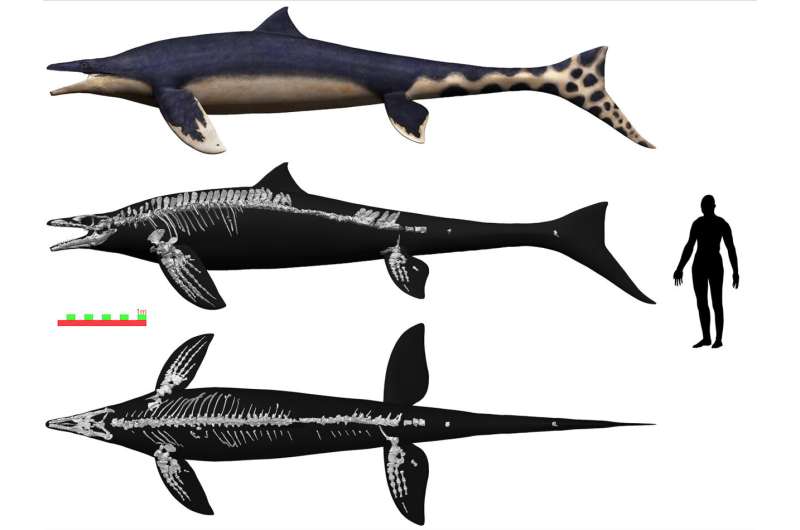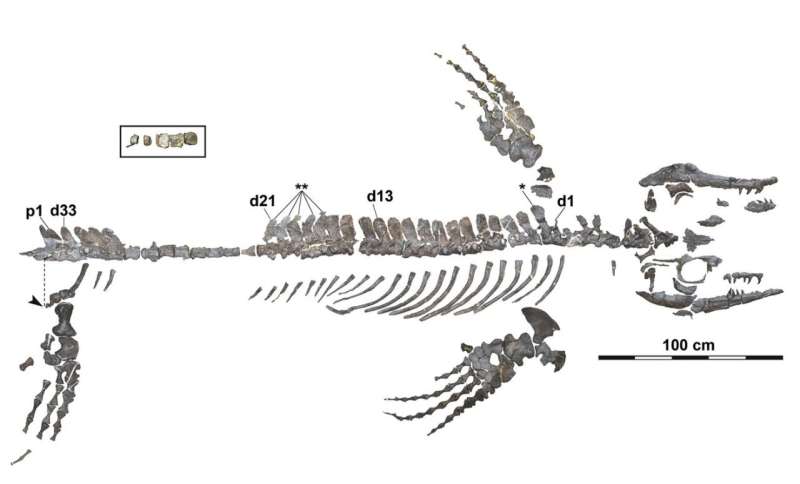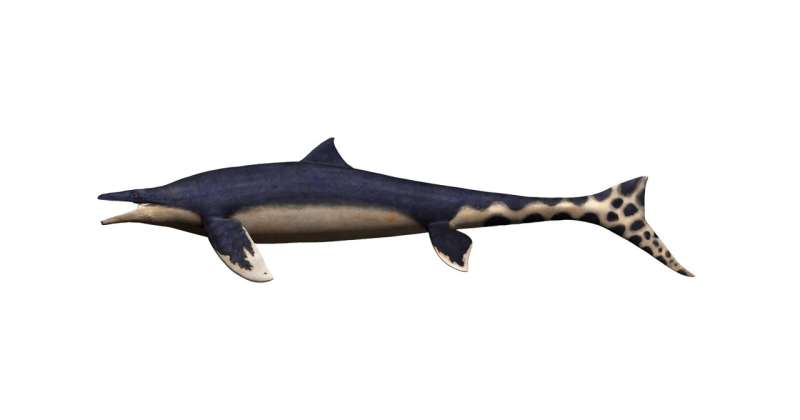This article has been reviewed according to Science X's editorial process and policies. Editors have highlighted the following attributes while ensuring the content's credibility:
fact-checked
peer-reviewed publication
trusted source
proofread
This Japanese 'dragon' terrorized ancient seas

Researchers have described a Japanese mosasaur the size of a great white shark that terrorized Pacific seas 72 million years ago.
Extra-long rear flippers might have aided propulsion in concert with its long finned tail. And unlike other mosasaurs, or large extinct marine reptiles, it had a dorsal fin like a shark's that would have helped it turn quickly and with precision in the water.
University of Cincinnati Associate Professor Takuya Konishi and his international co-authors described the mosasaur and placed it in a taxonomic context in the Journal of Systematic Palaeontology.
The mosasaur was named for the place where it was found, Wakayama Prefecture. Researchers call it the Wakayama Soryu, which means blue dragon. Dragons are creatures of legend in Japanese folklore, Konishi said.
"In China, dragons make thunder and live in the sky. They became aquatic in Japanese mythology," he said.
The specimen was discovered along the Aridagawa River in Wakayama by co-author Akihiro Misaki in 2006. Misaki was looking for fossils of invertebrates called ammonites when he found an intriguing dark fossil in the sandstone, Konishi said.
Misaki continued looking for ammonites before curiosity got the better of him and he returned to the dark bone. Closer examination revealed it was a vertebra, part of a nearly complete mosasaur captured in the hard sandstone.
The specimen is the most complete skeleton of a mosasaur ever found in Japan or the northwestern Pacific, Konishi said.
"In this case, it was nearly the entire specimen, which was astounding," Konishi said.
He has dedicated his career to studying these ancient marine reptiles. But the Japanese specimen has unique features that defies simple classification, he said. Its rear flippers are longer than its front ones. These enormous flippers are even longer than its crocodile-like head, which is unique among mosasaurs.
"I thought I knew them quite well by now," Konishi said. "Immediately it was something I had never seen before."

Mosasaurs were apex predators in prehistoric oceans from about 100 million years ago to 66 million years ago. They were contemporaries of Tyrannosaurus rex and other late Cretaceous dinosaurs that ruled the Earth. Mosasaurs were victims of the same mass extinction that killed off nearly all dinosaurs when an asteroid struck what is now the Gulf of Mexico.
The Wakayama Soryu has some features similar to mosasaurs found in New Zealand and other features comparable to mosasaurs found in California, he said.
It had nearly binocular vision that would have made it a lethal hunter, he said.
Researchers placed the specimen in the subfamily Mosasaurinae and named it Megapterygius wakayamaensis to recognize where it was found. Megapterygius means "large winged" in keeping with the mosasaur's enormous flippers.
Konishi said those big paddle-shaped flippers might have been used for locomotion. But that type of swimming would be extraordinary not only among mosasaurs but among virtually all other animals.
Another prehistoric marine reptile called the plesiosaur used its paddle fins for propulsion, but it didn't have a long rudderlike tail, he said.
"We lack any modern analog that has this kind of body morphology—from fish to penguins to sea turtles," he said. "None has four large flippers they use in conjunction with a tail fin."
Researchers speculated that the large front fins might have helped with rapid maneuvering while its large rear fins might have provided pitch to dive or surface. And presumably like other mosasaurs, its tail would have generated powerful and fast acceleration as it hunted fish.
"It's a question just how all five of these hydrodynamic surfaces were used. Which were for steering? Which for propulsion?" he said. "It opens a whole can of worms that challenges our understanding of how mosasaurs swim."

Unique to mosasaurs, the Wakayama Soryu apparently had a dorsal fin, based on the orientation of the neural spines along its vertebrae. The orientation of these spines is remarkably similar to that of a harbor porpoise, which also has a prominent dorsal fin, the study found.
"It's still hypothetical and speculative to some extent, but that distinct change in neural spine orientation behind a presumed center of gravity is consistent with today's toothed whales that have dorsal fins, like dolphins and porpoises," he said.
A team of researchers spent five years removing the surrounding matrix of sandstone from the fossils. They also took a cast of the mosasaur in place to provide a record of the skeletal orientation of the bones before they were excavated.
More information: Takuya Konishi et al, A new derived mosasaurine (Squamata: Mosasaurinae) from south-western Japan reveals unexpected postcranial diversity among hydropedal mosasaurs, Journal of Systematic Palaeontology (2023). DOI: 10.1080/14772019.2023.2277921
Journal information: Journal of Systematic Palaeontology
Provided by University of Cincinnati





















